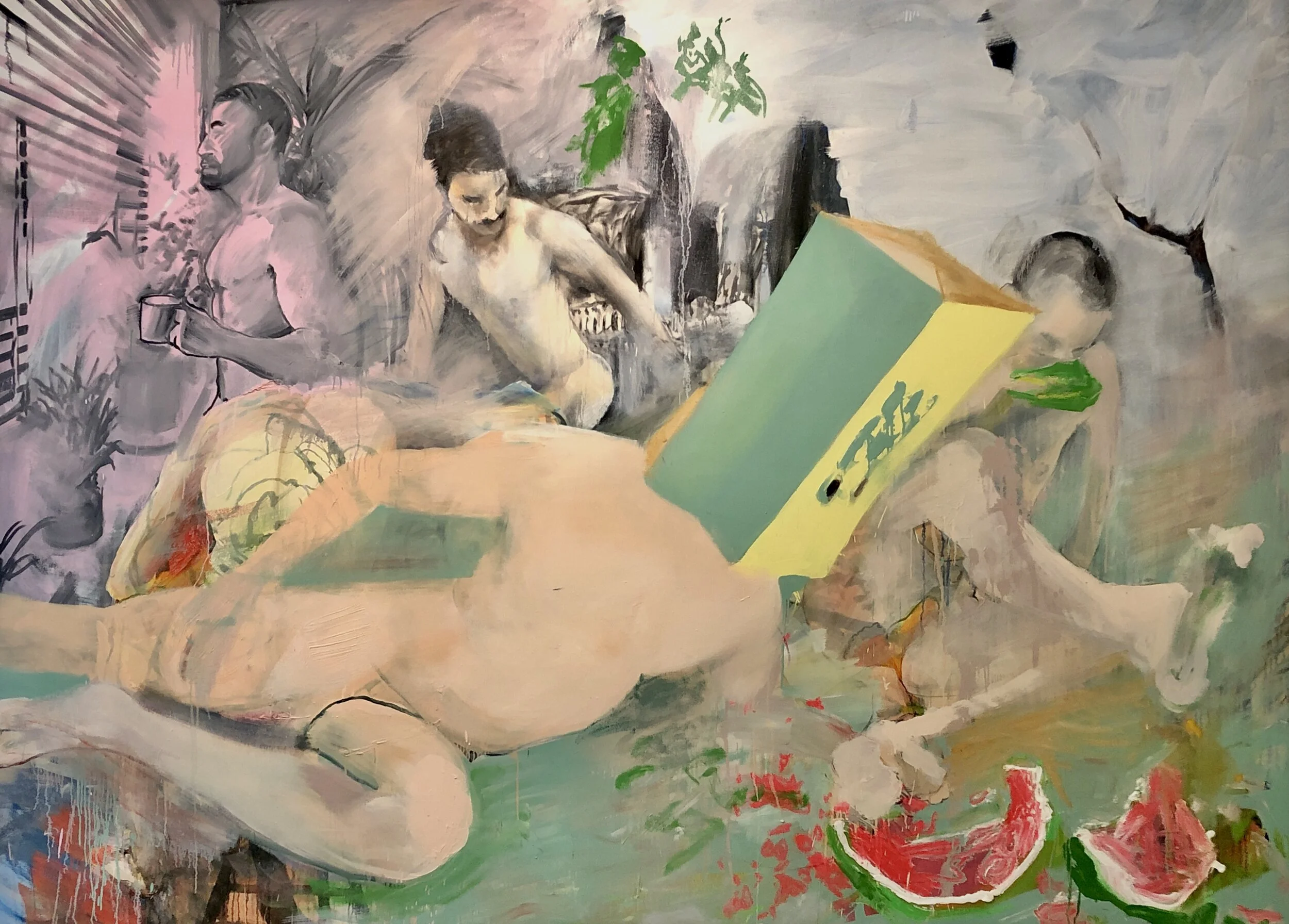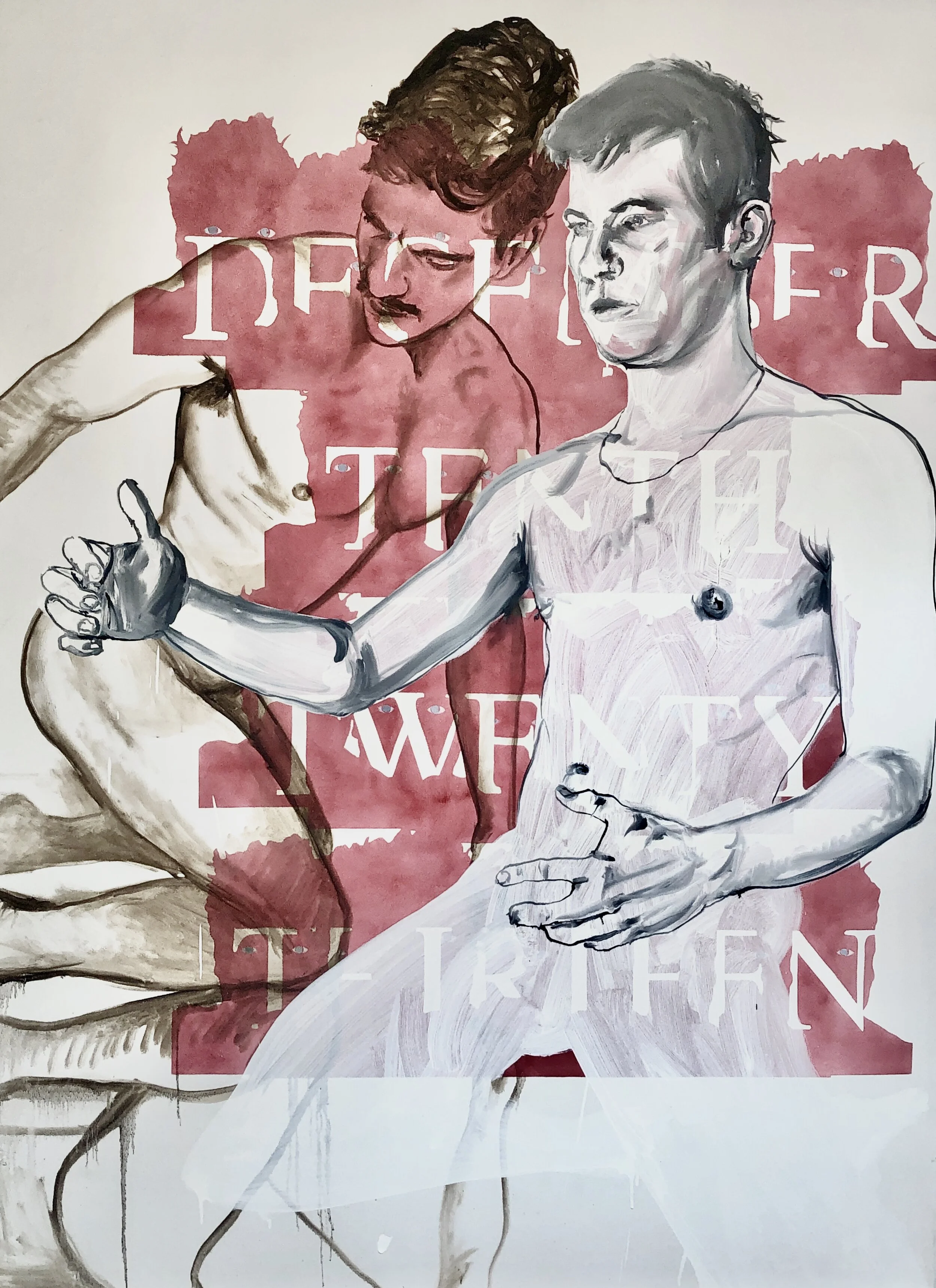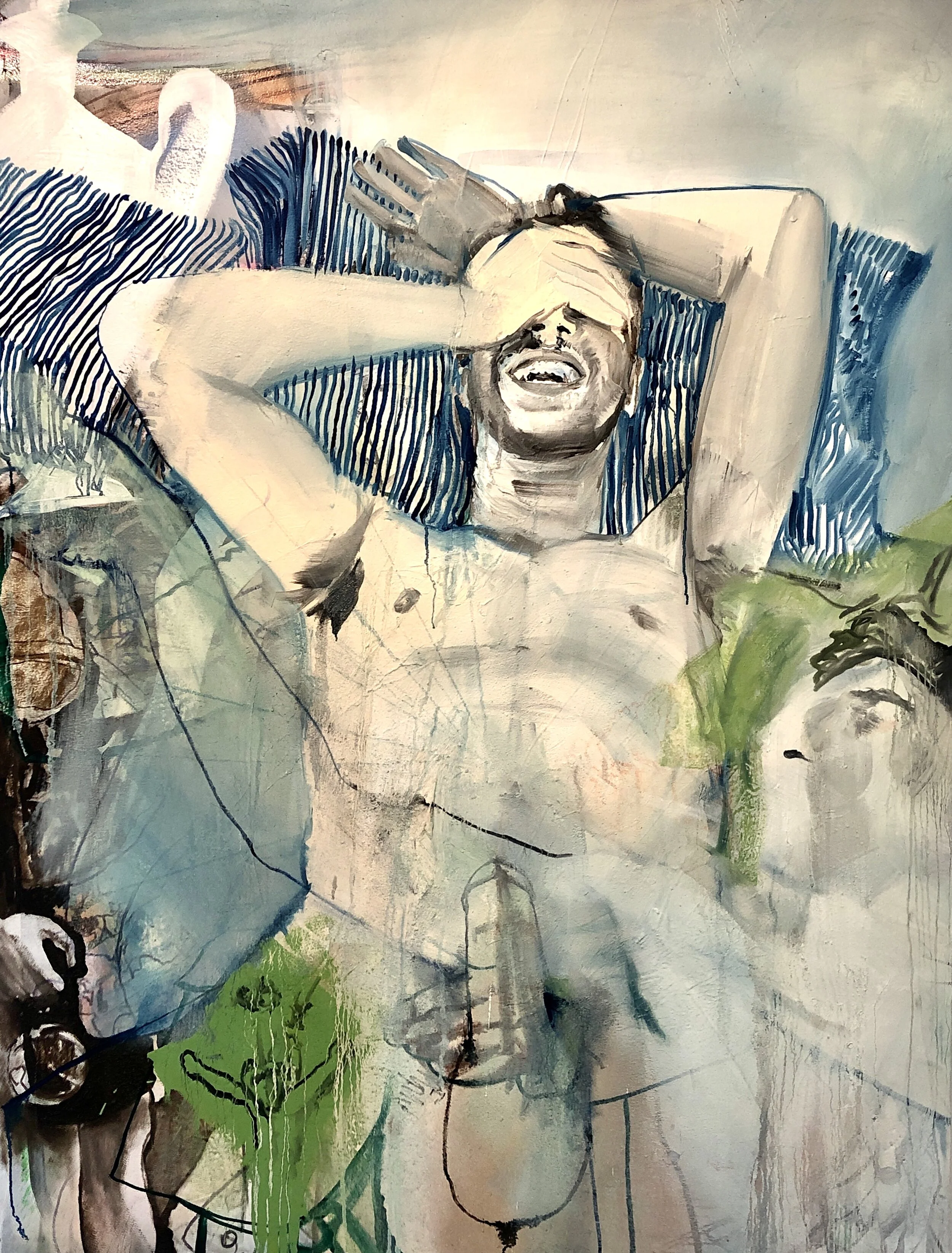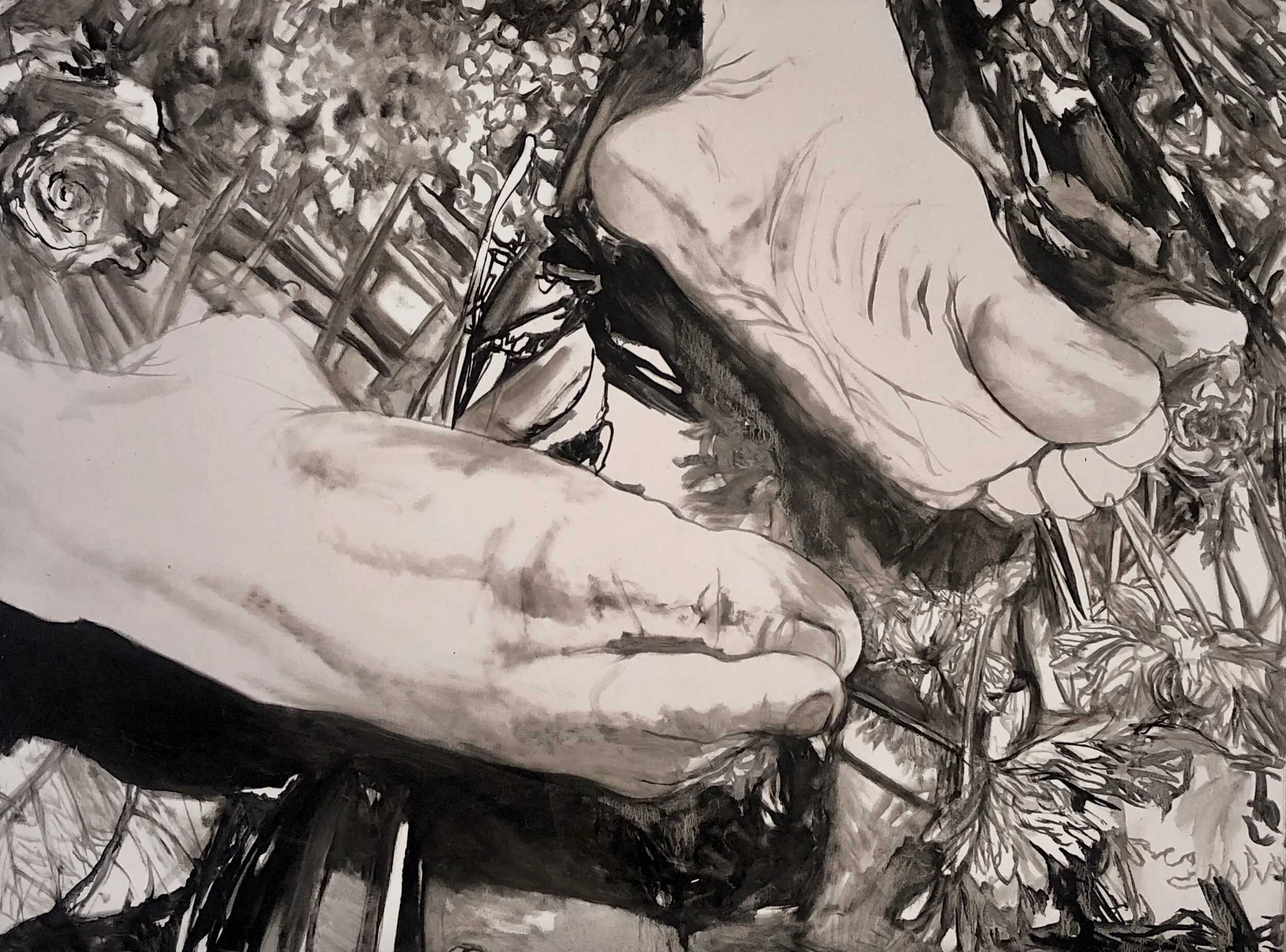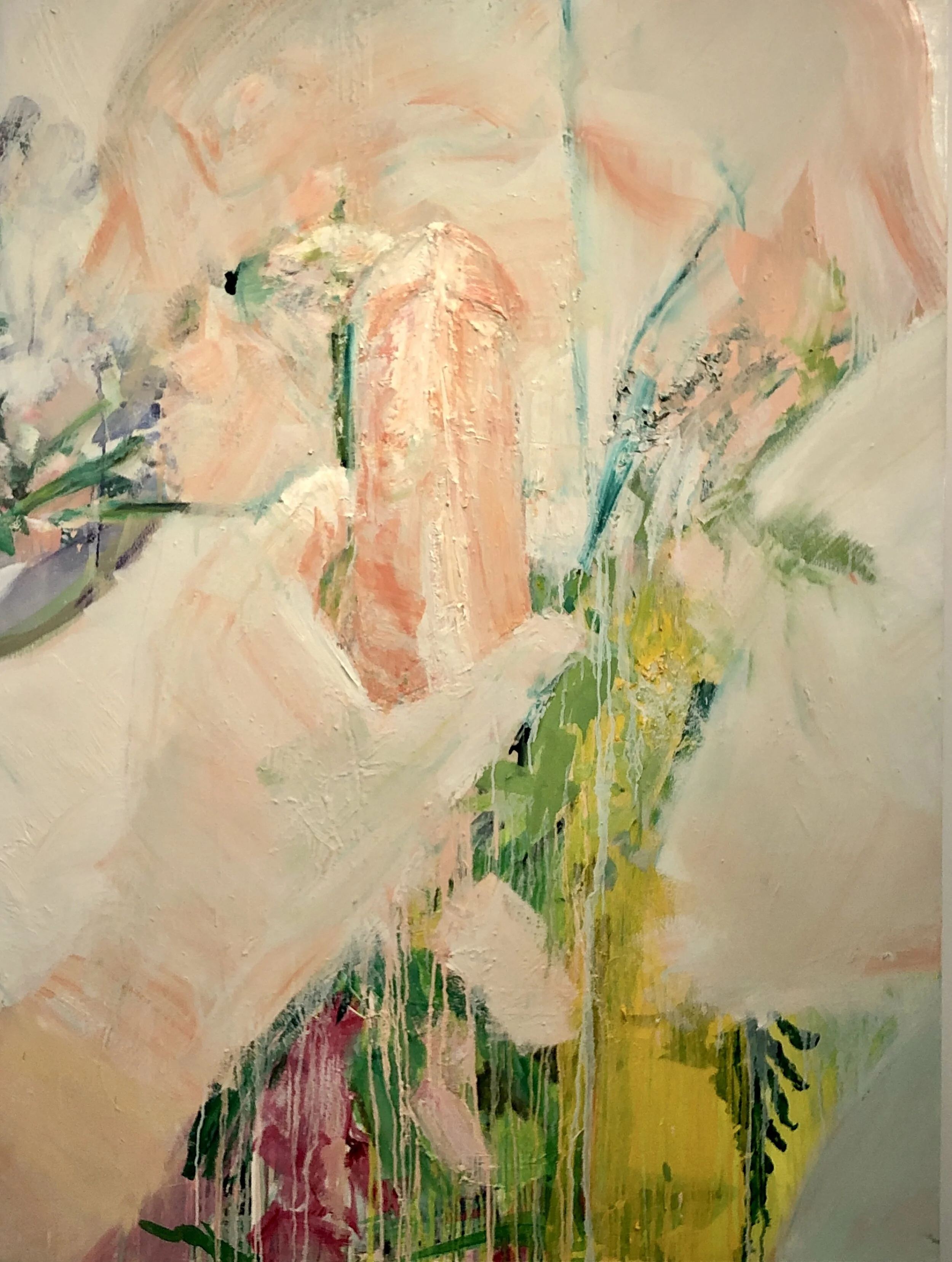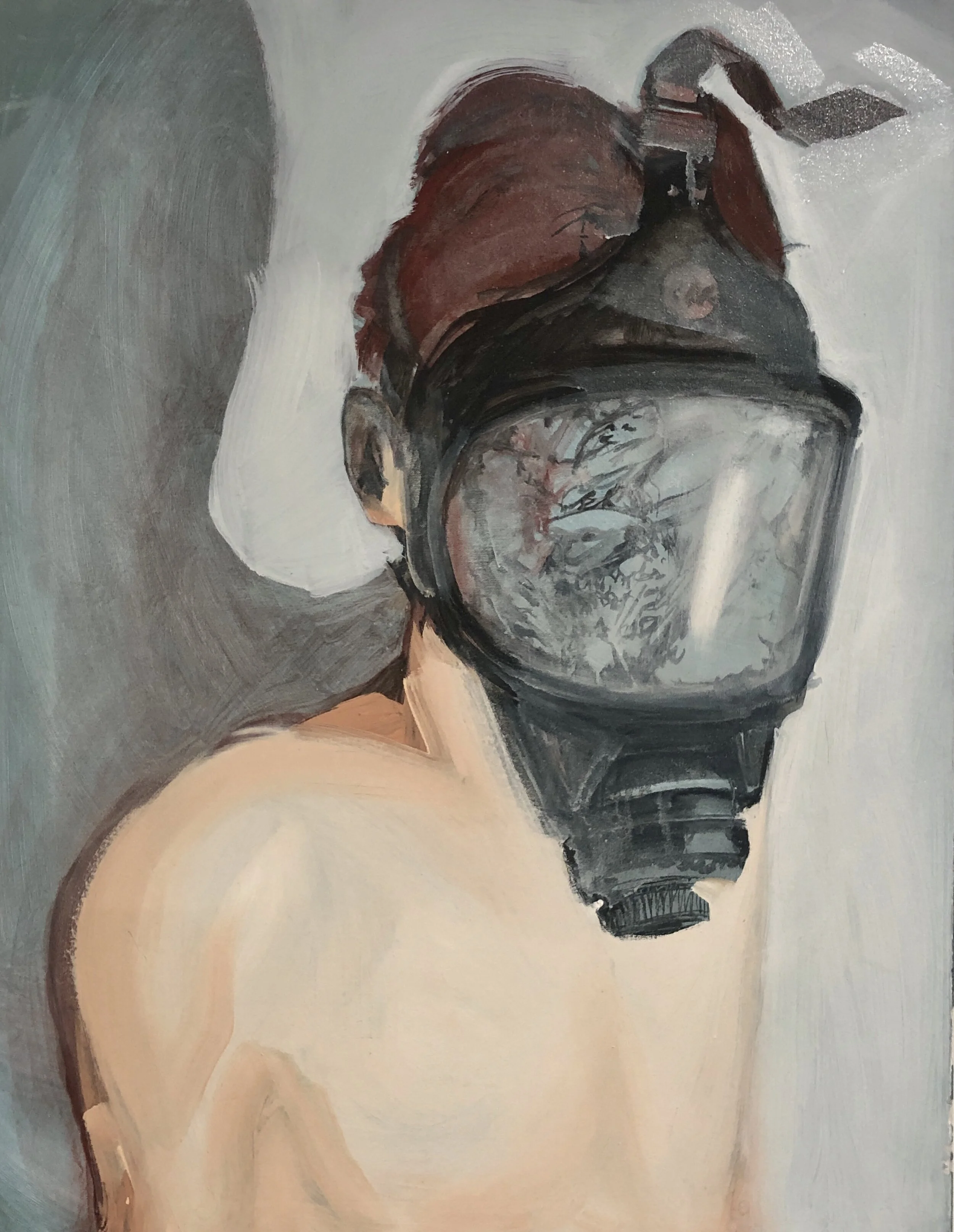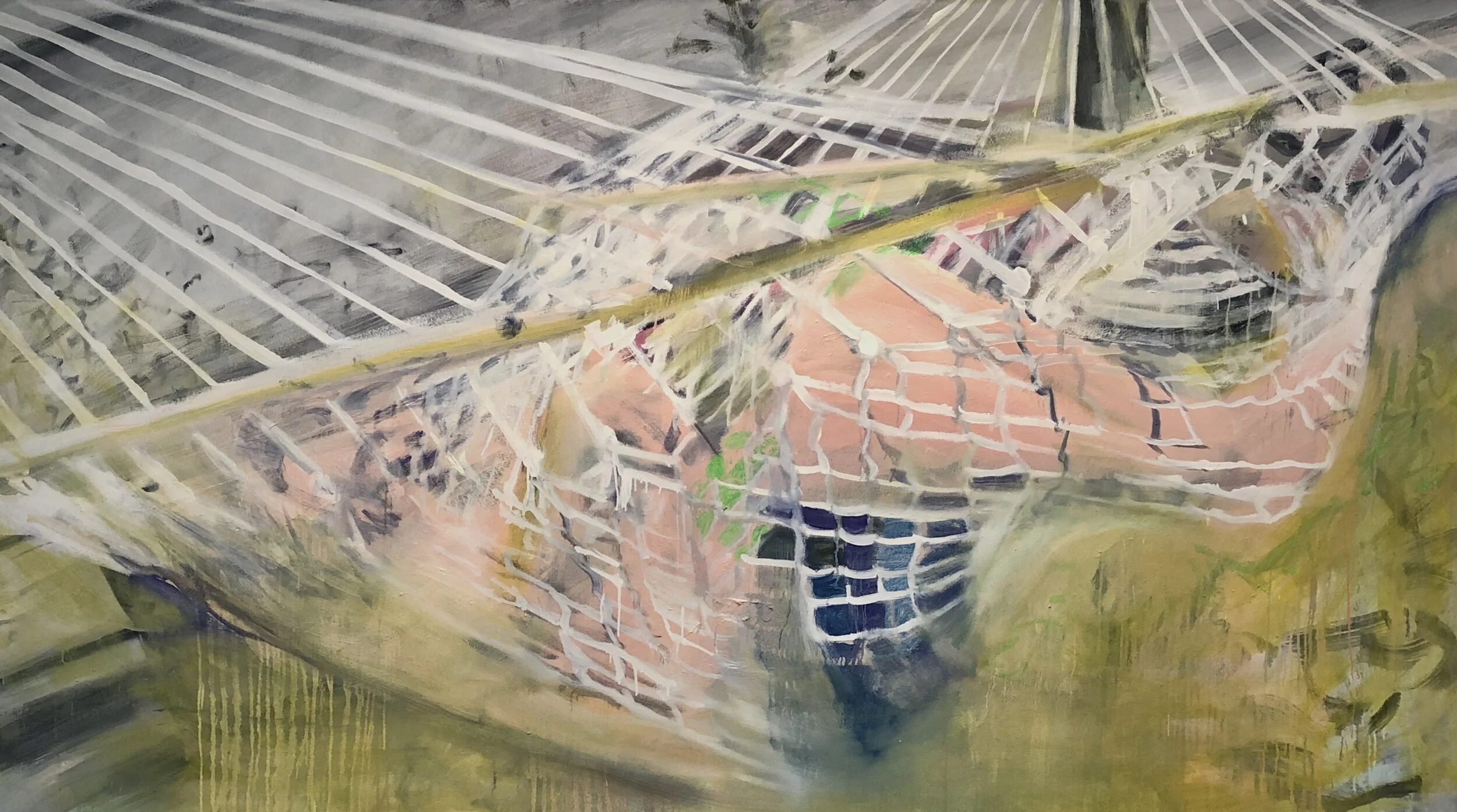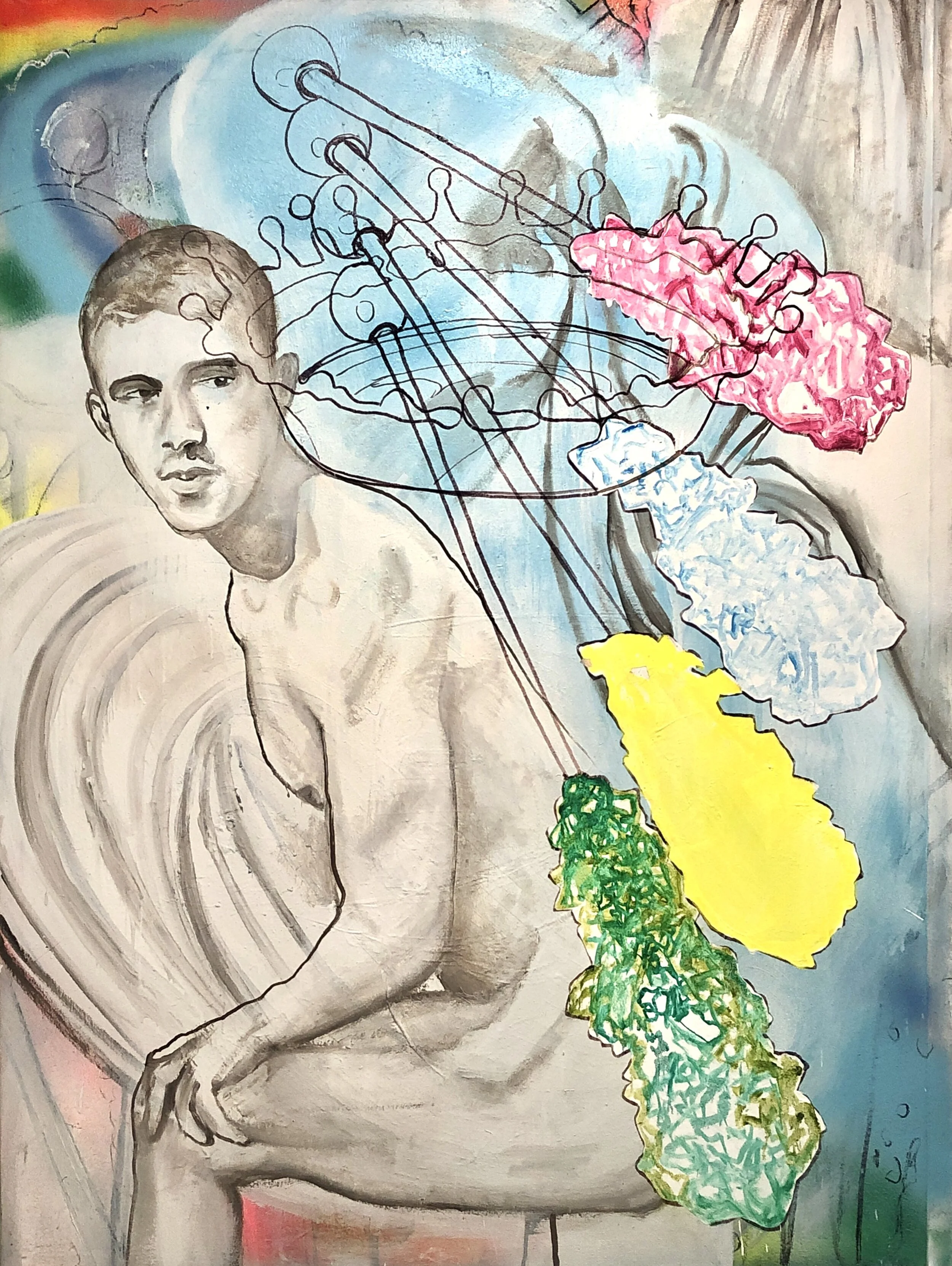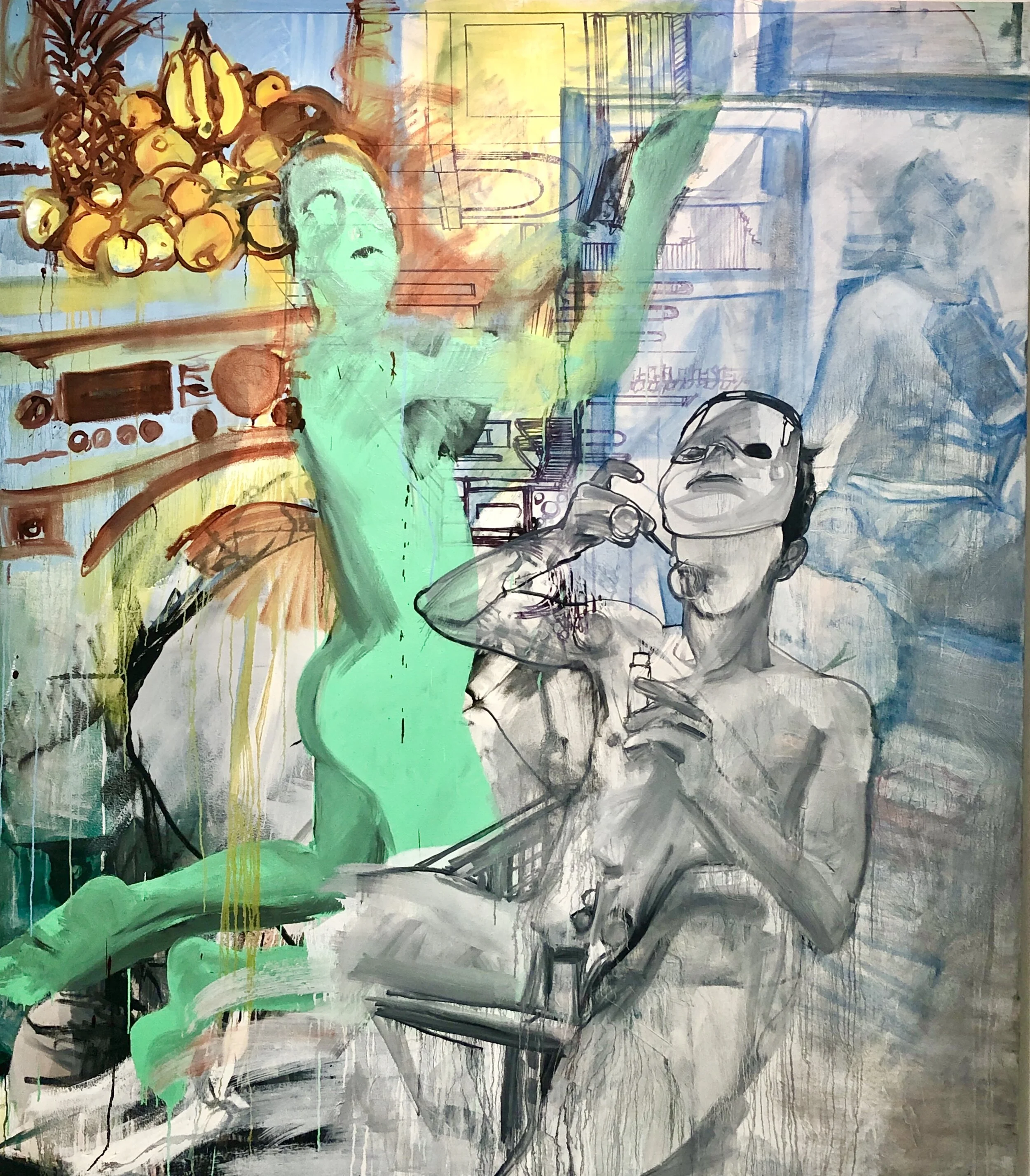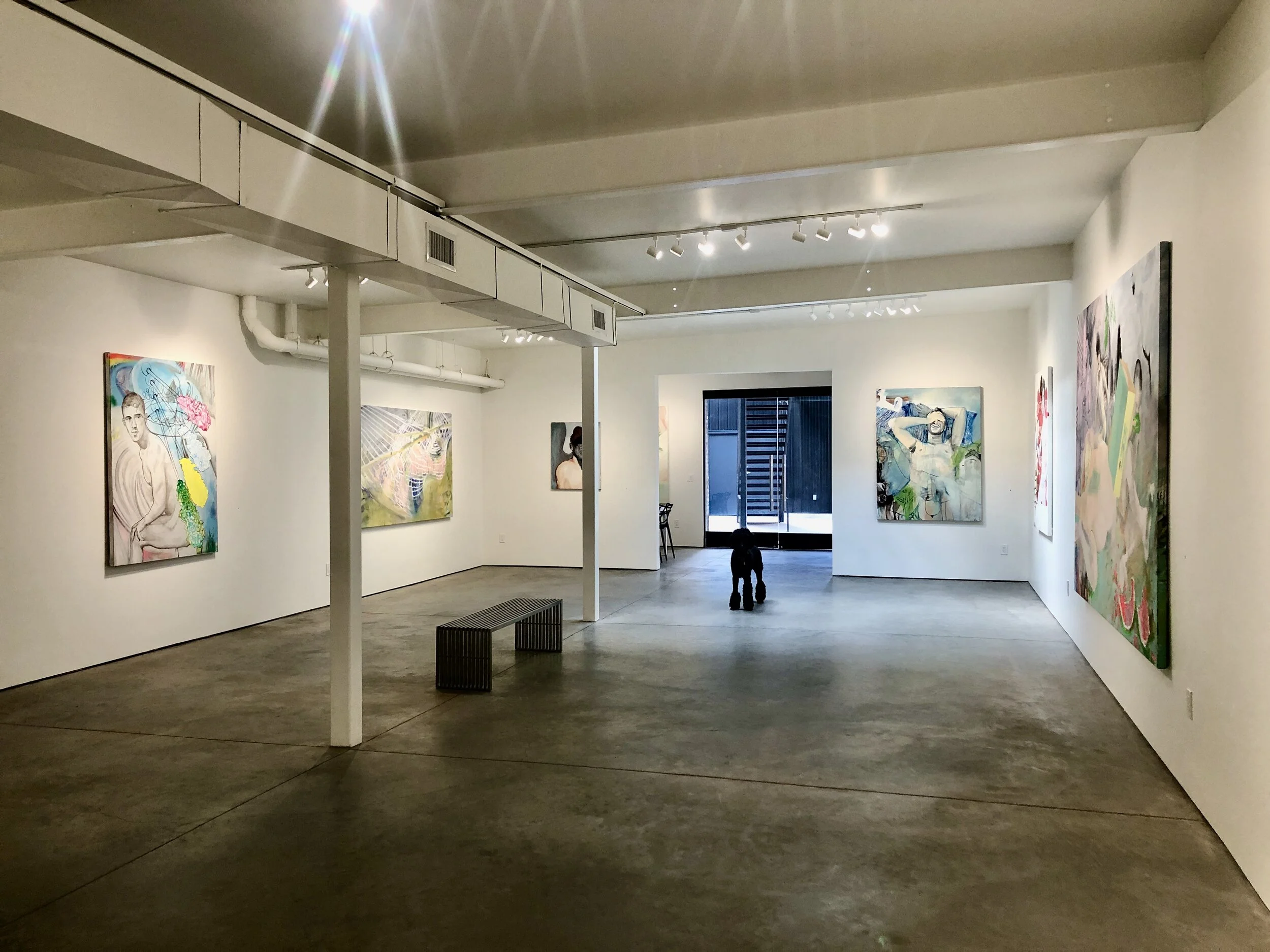7 August - 12 September
No Fruit Forbidden:
Alex Schmitz








No Fruit Forbidden Alex Schmitz
Quappi Projects is pleased to present Alex Schmitz’s No Fruit Forbidden. A native Kentuckian based in Brooklyn for the last decade, Schmitz's artistic practice includes photography but is primarily focused on painting. The new works in this exhibition explore his personal experience as a gay man and an idealized self within the context of a Candideian garden.
Reached at the end of Voltaire’s Candide (1759), the garden is the culmination of a long and arduous journey. It is a place of respite, albeit one where the characters must do work to achieve results. Not necessarily a dismissal of the pain and suffering that exists in the world outside the garden, Candide’s book-ending assertion “let us cultivate our garden” is perhaps rather an advocation for the creation of a contained universe of one’s own into which one can retreat when necessary. After a youth based in Kentucky tinged with repression and self-hatred, Schmitz began cultivating his own such garden upon moving to Brooklyn a decade ago, acknowledging that recognizing and honoring his own desires was essential to exploring his artistic impulses as well as the development of his personal happiness.
Working from a bank of saved photographs as well as sessions with live models in his live-work studio, Schmitz’s diaristic paintings are pushed and pulled in order to achieve his desired affect, which is a layered hybridization of representation and abstracted, painterly expression. He is drawn to chosen images because of particular formal qualities, but is also very much concerned with gentleness. This conscious choice plays out even in the application of paint. Although the figures in part do refer to specific people, they are not to be understood as individual portraits, but rather amalgams of a collection of friends, lovers, and muses that all play active roles in the artist’s life and in this body of work serve as idealized stand-ins for Schmitz himself.
Schmitz’s work is also in conversation with that of earlier artists who depicted versions and visions of male homosexuality. His figures, contained within complex compositions, are surrounded by multiple viewpoints and often coexist on different planes, calling to mind the work of Larry Rivers (1923-2002). Schmitz’s line work bears some stylistic similarity to the drawings of British artist Keith Vaughn (1912-1977), although much of Vaughn’s work seems possessed with an underlying sense of fear and repression with regard to homosexuality, whereas Schmitz’s is unabashedly celebratory, intimately capturing his subjects when they are ripe, ready, and at their most desirable. Other influences are many, and Schmitz’s work adds to a rich tradition.
In both art as well as in life, frank depictions of queer love or even queer experiences have long been deemed shocking, outré or explicitly political. One might contend that our culture has evolved to such a degree that this is no longer the case, yet it was only this summer - 2020! - that the U.S. Supreme Court ruled (6-3) that workers cannot be fired by employers for being LGBTQ+, and religious organizations are still mostly exempt from abiding by this ruling. While much has improved over the last few decades, every advancement has been met with fierce and powerful opposition and LGBTQ+ citizens have not yet achieved full equality. In that sense, Schmitz’s works, clearly made and imbued with joy and erotic candor, are still radical. Yet his plain, clear-eyed depictions of love, desire, connection and the simple occurrences and pleasures of everyday life are also precisely the opposite. That these two diametric obverses can both simultaneously be true seems to be the point of exalting the lushness of the garden Schmitz has created for himself and his chosen circle.
- John Brooks
Alex Schmitz hails from Northern Kentucky and now lives in Brooklyn, New York. He is founder and curator of Taaffe Gallery, an exhibition space adjacent to his Clinton Hill art studio. Alex received his BFA in Painting in 2007 from the University of Louisville, and his MFA from Syracuse University in 2011.
Carapace 2019, oil on canvas, 47x64x1.5” $5200
Puckered Up 2019, oil on canvas, 64x95x1.5” $8500
No Fruit Forbidden 2020, oil on canvas, 115x82x1.5” $18000
December Tenth 2019, oil on canvas, 47x64x1.5” $5200
Kill Me With Pleasure 2020, oil on canvas, 47x 64x1.5 $5200
Garden Path 2020, oil on canvas, 48x36x1.5” $3800
Rock Hard 2020, oil on canvas, 47x64x1.5” $5200
Mask 2020, oil on canvas, 28x36x1.5” SOLD
Bottomed Out 2020, oil on canvas, 96x53x1.5” $7000
Rock Candy 2019, oil on canvas, 47x64x1.5” $5200
Our Bounty 2020, oil on canvas, 72x83x1.5” $11000
Past Exhibitions
Kiah Celeste, Dominic Guarnaschelli, J. Cletus Wilcox
A Sort of River of Passing Events
Brooklyn native Kiah Celeste and Louisville natives Dominic Guarnaschelli and J. Cletus Wilcox are three Louisville-based artists whose disparate practices converge around ideas related to formal concerns, aesthetics, materiality, abstraction, process, and ambiguity of meaning.
I Do Not Ask Any More Delight: the body and contemporary intimacy
I Do Not Ask Any More Delight: the body and contemporary intimacy, features the work of nineteen diverse artists from Louisville, New York City, Brooklyn, Los Angeles, Dayton, Seattle, as well as Germany and Brazil.
L Autumn Gnadinger
Notably Untested Spiritual Gestures
Devotionals in search of a creed, relics desirous of believers, L Autumn Gnadinger's works neither promise healing, nor that such a thing is even possible, but they exist as instruments to nurture metaphorical experiences in an effort to find meaning and a sense of belonging.
Megan Bickel
we_are_inside_the_fire
Approaching her practice from the perspective that making relevant work requires knowledge about such diverse subjects as aesthetics, politics, science, economics, and history, Bickel employs disparate and unusual materials while using the visual language of painting to play with ideas related to perception, experience, ethics, and painting itself.
Jacob Heustis
Beasts Will Be Still There
Full of cryptic imagery, pop culture and art historical references, grand in scale and complex in technique and content, these paintings befit our uncertain and discordant times. Formidable beasts, familiar icons, and mythological and symbolic figures loom in imaginary spaces just as they haunt our culture’s unconscious collective psyche.
Letitia Quesenberry
(((heat)))
By combining disparate materials such as color correction film, beeswax, and sanded plexiglass with reflective or opaque materials like resin, graphite, LEDs, plaster, paint, mirrors, coal slag, and mica dust, Quesenberry creates moments of hypnotic bewilderment and intense communication.
Jake Ford
Unveiled
Ford’s work is a rejection of binary social systems which tend to control how we view ourselves and those around us. Using imagery and form inspired by nature and unconscious desire, this work encourages the viewer to confront the inner self, specifically the parts we repress and reject.
Jim Zimmer
Often the content is impenetrable
Zimmer utilizes common yet unexpected materials, working with a kind of automatism, exploring the boundaries of art and object, and the possibilities of parameterless creation.
Deborah Spanton
West Coast Jazz
Late last year Spanton began making work for this exhibition thinking generally about what it has meant to be a woman, but as events unfolded in 2018, her focus became more specifically concerned with the #metoo movement and her own experiences navigating through the world of dangerous men.
Vanessa Albury
All Things That Are, Are Light and Soot
Inspired by the build-up of history in dirt, dust and ivy accumulated and grown over forgotten windows on industrial buildings and her own family history, photography-based artist Vanessa Albury has created mural-scaled cyanotypes of massive and filth-caked windows in our own Portland neighborhood, just several blocks from where her grandfather William Rihn had, for many years, a machine shop on Main Street and a few miles from Six Mile Island, where her Cherokee great-great-grandparents lived.
Don’t Turn Around Don’t Look Down
This diverse group of artists share common space, energy, and a roof, but each works in his or her own individual manner and with sundry materials. Our exhibition seeks to explore the ways in which, if any, our proximity affects the course of our respective practices.
Michael James Moran
Binding What’s Lost
Moran's distinct bodies of sculpture are tied together through the essential act of questioning our human relationships with the natural world: the damage we've done, the history we forget, the beauty we overlook. Through the manipulation and framing of wood, he addresses these losses, and in binding them together readjusts our eyes to perceive the multi-faceted nature of this material: the trees which grow, which once grew.
Whit Forrester
Photosynthetic Transfigurations: A Work in Progress
Forrester’s photographs are unique art objects; gold leaf is applied by hand to each individual work. Gold stands in for the divine because it is ineffable; in a way it is a form of light. Forrester’s gold circles and semicircles are reminiscent of the halos of numerous saints in medieval and Renaissance artworks, but they riff on those traditional representations of überholiness and instead depict the universality of the divine from a perspective of new materialism, queerness, and quantum feminism.
Vian Sora
N O W H E R E
Born in Baghdad, Iraq, the entirety of Sora’s youth was spent under the inescapable shadow of Saddam Hussein and the Ba’ath Party; the personal stories and journeys of her family and friends are inseparable from what she describes as the “mandates and masochism” of one of the 20th century’s most cruel and craven dictators.
Adam Chuck
Instant Gratification
Taking found photos, curated by amateur photographers rendering them in paint at an intimate scale, he takes these explicit moments and presents them like specimens or a small photo like a Polaroid, examining the way many humans present themselves on the internet.



